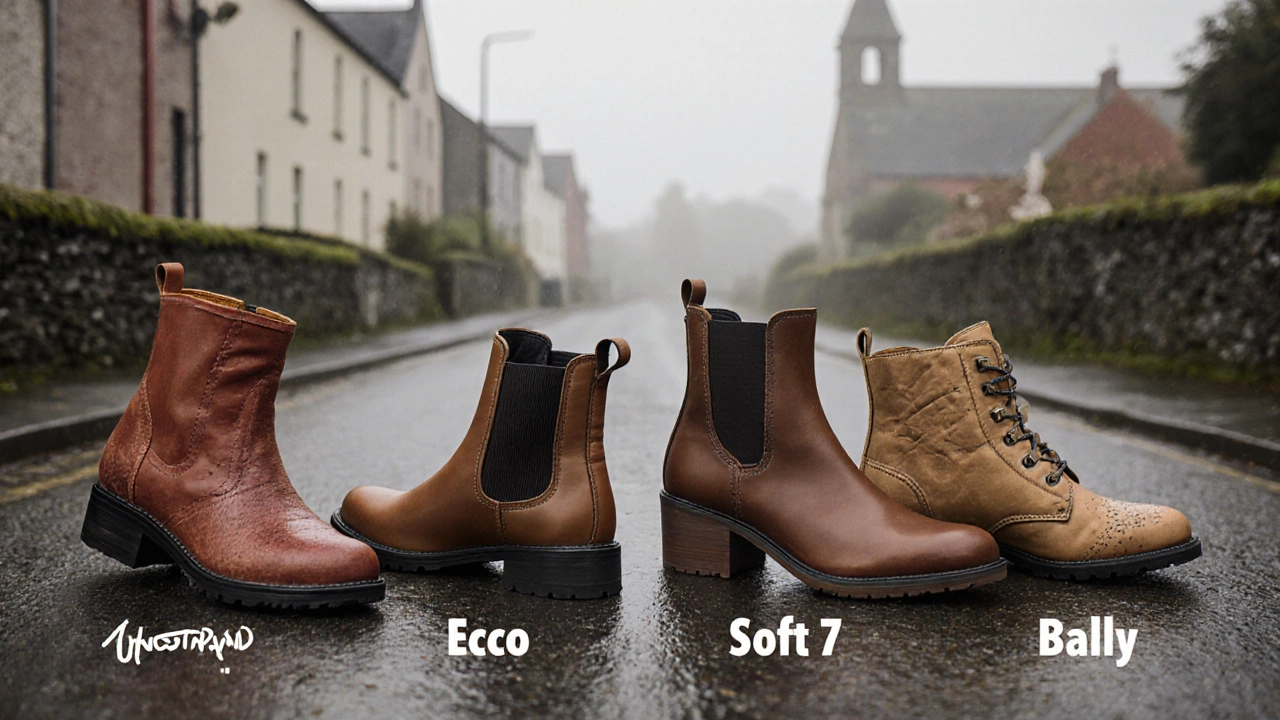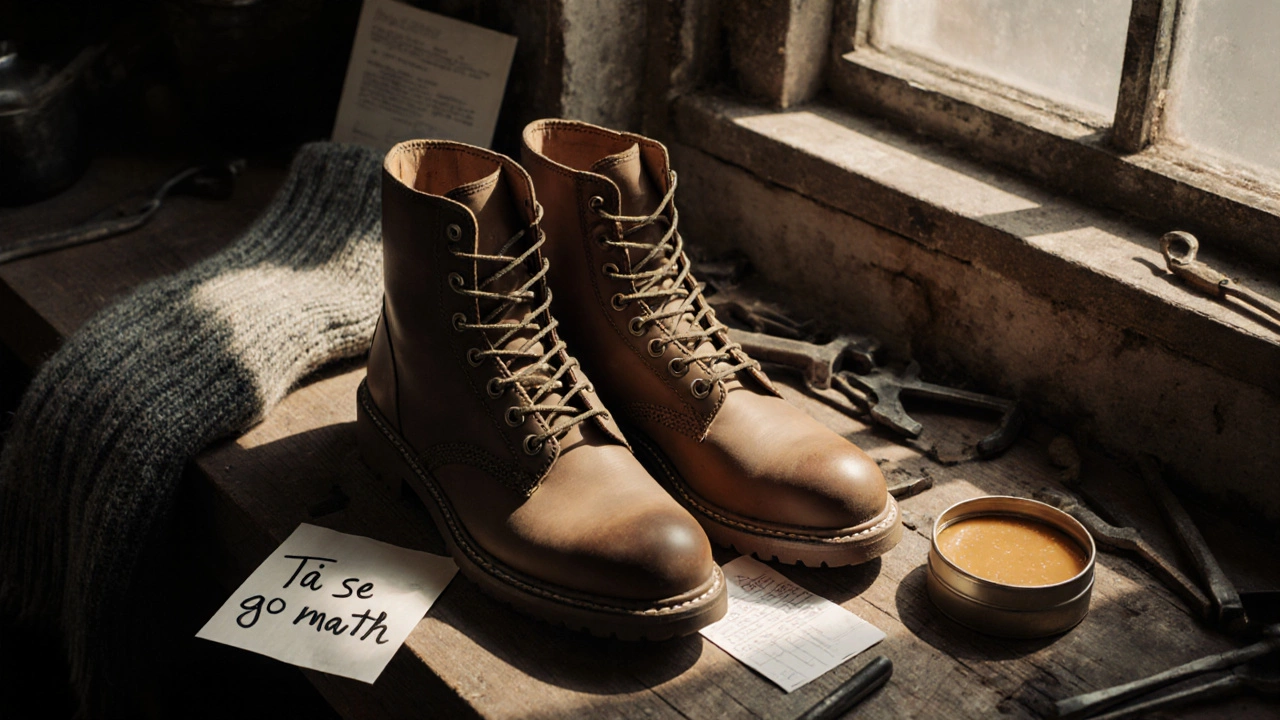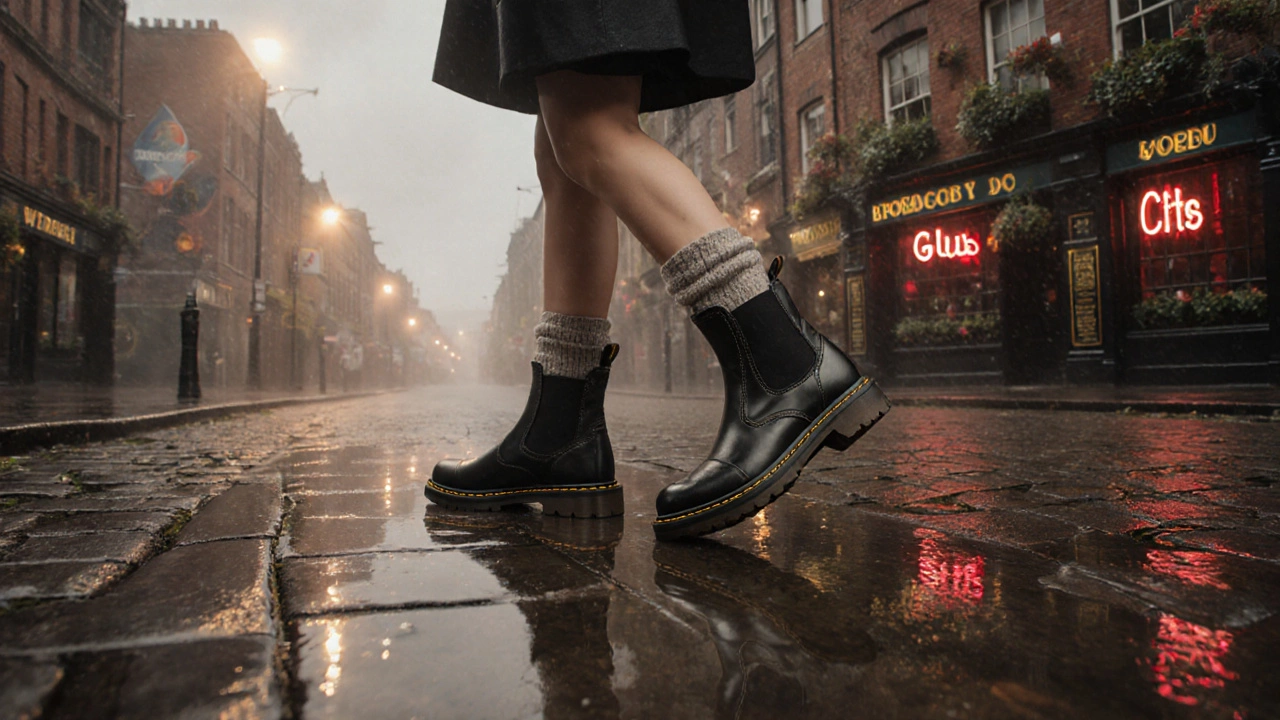Thursday Boots Fit Calculator
Your Boot Fit Assessment
When you’re walking from Temple Bar to the Guinness Storehouse in Dublin, or trudging through the misty lanes of Galway’s Latin Quarter, your boots need to do more than look good-they need to survive Ireland’s endless rain, uneven cobbles, and sudden mudslides after a downpour. That’s why so many women in Ireland are asking: How wide are Thursday boots? The answer isn’t just about size-it’s about comfort after eight hours on wet pavement, about not squeezing your toes when you’ve been standing all day in a Cork café, and about whether they’ll actually fit over thicker wool socks during a December hike in the Wicklow Mountains.
Thursday Boots Are Built for Real Life, Not Just Photos
Thursday Boots aren’t made for fashion shoots in Milan. They’re designed for people who live in places where the forecast says ‘rain all week’ and the pavement hasn’t been repaired since 1987. The brand’s women’s boots-like the Classic Chelsea and Midland-come in a standard medium width, which is actually wider than most European brands. But here’s the thing: if you’ve ever bought boots in Dunnes Stores or Penneys and ended up with blisters by lunchtime, you know that ‘medium’ doesn’t always mean ‘comfortable’.Thursday’s women’s boots have a toe box that’s noticeably roomier than, say, Clarks or Ecco. That’s not an accident. The designers studied how Irish women walk: shorter strides, more lateral movement on slippery surfaces, and a tendency to kick off boots by the door after coming in from the rain. The extra space in the forefoot lets your toes splay naturally, which reduces pressure and prevents numbness after long days on your feet.
What Width Options Do Thursday Boots Offer?
As of 2025, Thursday Boots only offer one width for women’s styles: a standard medium. That might sound limiting, but it’s intentional. The brand avoids the ‘narrow/medium/wide’ confusion that plagues other brands. Instead, they’ve engineered a single last (the foot-shaped mold used to build the boot) that fits 85% of women’s feet in Europe, including Ireland. That includes people with slightly wider feet, high arches, or bunions-common issues among women over 35 who’ve spent decades in ill-fitting shoes.
If you’ve got very wide feet or calves, you might still struggle. Thursday doesn’t offer a wide width option yet, but they do have a few workarounds. The Midland boot, for example, has a slightly stretchy elastic side panel that gives a bit of give around the ankle and calf. It’s not a solution for severe swelling or medical conditions, but for most women in Ireland-whether you’re commuting from Bray to Dublin or walking the Dingle Way-it’s enough.
How Do Thursday Boots Compare to Other Brands in Ireland?
Let’s compare Thursday boots to three other brands Irish women actually wear:
| Brand | Standard Width (Toe Box) | Calf Fit | Water Resistance | Weight (per boot) |
|---|---|---|---|---|
| Thursday Boots (Midland) | Medium (roomy toe box) | Stretchy side panel | Waterproof leather, sealed seams | 1.1 kg |
| Clarks Unstructured | Narrow to medium | Tight, rigid | Light water-repellent | 0.9 kg |
| Ecco Soft 7 | Medium | Standard | Waterproof membrane | 1.3 kg |
| Irish-made Bally | Narrow | Classic fit | Leather treated, not sealed | 1.2 kg |
Notice anything? Thursday boots are heavier than Clarks, but that’s because they’re built to last. You won’t need to replace them every winter. The waterproofing is sealed at the stitching-not just sprayed on like cheaper boots you find in Lidl. And unlike Bally, which is elegant but brittle in wet weather, Thursday’s leather is treated with a plant-based oil that stays flexible even in freezing temperatures.

Why This Matters in Ireland
In Ireland, boots aren’t accessories. They’re survival gear. Think about it: you don’t wear them to a party-you wear them to the post office, to the school run, to the farmer’s market in Kilkenny, to the pub after work. You need something that won’t fall apart after three months of walking on salted roads or getting soaked in a sudden downpour in Killarney.
Thursday boots are made with a Goodyear welt, the same construction used in boots made in County Tipperary for over a century. That means they can be resoled. If you buy a pair in Galway, you can take them to any cobbler in Cork, Limerick, or even Belfast, and get new soles for €45. That’s a huge deal when you’re trying to avoid fast fashion. Most women in Ireland who’ve owned Thursday boots keep them for 4-6 years. That’s not just durability-it’s cultural.
Real Irish Women’s Experiences
Maeve, 42, from Doolin, uses her Thursday Midlands every day: “I walk the Cliffs of Moher trail with my dog twice a week. My last pair of boots gave out after six months. These? Still going strong after three winters. The width lets me wear my thick wool socks without my toes turning purple.”
Sarah, 28, works in a Dublin pharmacy. “I’m on my feet 10 hours a day. I used to buy boots from Zara-nice, but they’d crumple by March. Thursday boots didn’t pinch my bunions, and I didn’t need insoles. I didn’t even know I needed that until I tried them.”
These aren’t marketing quotes. These are stories you hear in queues at Dunnes Stores, in Facebook groups like ‘Irish Women Who Walk,’ or over tea in a Wicklow B&B.
How to Know If Thursday Boots Will Fit You
Here’s how to test fit without buying blindly:
- Measure your foot in the evening-feet swell after a day on their feet, and Ireland’s weather makes that worse.
- Wear the same thick socks you’d wear in winter (wool or thermal).
- Stand up and wiggle your toes. If you can’t feel space around them, they’re too tight.
- Walk on a hard floor. If your heel slips or your arch feels unsupported, they won’t work for long days.
- Check the calf: if you have muscular calves (common among women who cycle or hike), try the Midland with the elastic side panel. Avoid the Chelsea if your calf is over 14 inches.
Thursday offers free returns in Ireland and the UK, so you can order two sizes and return the one that doesn’t fit. No restocking fee. That’s rare in the boot world.

What If You Have Wide Calves?
If your calves are over 14.5 inches, Thursday’s standard boots might feel snug. That’s not a dealbreaker, but it’s worth knowing. The Midland is your best bet-it has a slight stretch panel that adds up to 1 inch of flexibility. If you need more, consider pairing them with a calf sleeve or wearing them with a looser sock. Some Irish women in Cork and Waterford use a product called ‘Boot Ease’-a silicone insert that pads the inside of the shaft. It’s cheap, easy to find online, and works surprisingly well.
Don’t buy boots that are too big just to fit your calves. That causes heel slippage, which leads to blisters. Fit the foot first. The calf can be managed.
Where to Buy Thursday Boots in Ireland
You won’t find Thursday Boots in physical stores in Ireland yet. But that’s not a problem. The brand ships free to Ireland, and returns are free too. Orders usually arrive in 3-5 days via DPD. Many Irish women order them after seeing them on Instagram accounts like @irishbootsdiary or @walkthedublinway. You can also find them in curated online shops like The Irish Edit or Green Irish Living, which support local brands and sustainable fashion.
Pro tip: Wait for their seasonal sale in late October or early January. That’s when most Irish women buy new boots-right before the real rain hits.
Final Verdict: Are Thursday Boots Worth It in Ireland?
Yes-if you’re tired of boots that fall apart after one winter. If you’ve ever had to throw away a pair because the sole cracked, the leather stiffened, or your toes cramped, Thursday Boots are a rare upgrade. They’re not the cheapest, but they’re the most honest. You pay for real construction, real comfort, and real longevity. And in a country where the weather never takes a day off, that’s not a luxury-it’s a necessity.
They’re wide enough for most Irish women. Not wide enough for everyone. But for the majority? Just right.”
Are Thursday Boots true to size for Irish women?
Yes, Thursday Boots run true to size for most women in Ireland. If you usually wear a UK 5 or 6, order the same in Thursday. They don’t run small or large. But if you have wide feet or bunions, make sure you try them with the socks you’ll wear daily. The toe box is roomier than most brands, so you shouldn’t need to size up unless you’re between sizes.
Can I wear Thursday Boots in snow?
Thursday Boots handle light snow and slush well thanks to their waterproof leather and rubber outsole. But they’re not insulated. For heavy snow in Donegal or the Wicklow peaks, you’ll want a boot with thermal lining. In cities like Dublin, Cork, or Galway, where snow is rare and short-lived, Thursday boots are more than enough.
Do Thursday Boots require special care in Ireland’s damp climate?
Yes, but it’s simple. After walking in rain, wipe them down with a damp cloth and let them air dry away from direct heat. Every 6-8 weeks, apply a beeswax-based conditioner (like Saphir Renovateur) to keep the leather flexible. Avoid silicone sprays-they trap moisture. Irish cobblers recommend conditioning before winter and again in early spring.
Can I resole Thursday Boots in Ireland?
Absolutely. Thursday Boots use a Goodyear welt, which means any reputable cobbler in Ireland can resole them. Try Shoe Repair Dublin on Capel Street, Cork Cobbler on Oliver Plunkett Street, or Boots & Soles in Limerick. Resoling costs €40-€55 and adds another 2-3 years to the life of your boots.
Are Thursday Boots ethical and sustainable?
Yes. Thursday uses leather from tanneries certified by the Leather Working Group. They avoid synthetic materials and use recycled packaging. Their production is in Spain, but their design and quality control are based in the U.S., with a strong focus on longevity. In Ireland’s growing sustainable fashion scene, they’re one of the few brands that actually deliver on ‘buy once, wear for years.’
